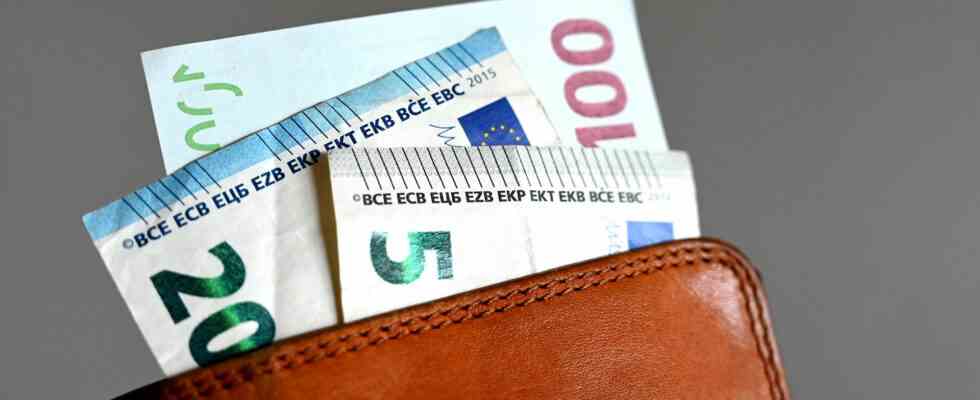Status: 06/29/2022 08:28 a.m
Today the Federal Statistical Office announces the inflation rate for June. It is again likely to differ greatly from the rate of inflation calculated by the EU statistical authority. Which one is more meaningful?
For months, consumers in Germany have had to dig deeper and deeper into their pockets. In May, the inflation rate climbed to its highest level since the first oil crisis in the winter of 1973/1974. According to the Federal Statistical Office (Destatis), prices were 7.9 percent higher than in May 2021 and rose more than ever before in reunified Germany. The statistical office of the European Union (Eurostat) calculated an even higher inflation rate of 8.7 percent for Germany. This means that the price increase in Germany is above the average in the euro zone, which was 8.1 percent in May.
When the Federal Statistical Office publishes the first estimate of the inflation rate for June today, the differences between the inflation rates calculated by Destatis and Eurostat are likely to be similar. Such serious deviations of almost one percentage point in the information on price increases are no longer uncommon. For months, the Eurostat figures and the inflation rate calculated in Germany have been drifting apart more and more. Why is that?
Two different indices as a basis for calculation
This is due to two different consumer price indices (CPI) used to calculate the inflation rate. The national CPI measures the average price development of all goods and services that households buy for consumption. In addition, the Harmonized Index of Consumer Prices (HICP) was developed in the European Union, which makes price changes internationally comparable. “The HICP tries to represent a measure of price stability,” Alexander Kriwoluzky, head of the macroeconomics department at the German Institute for Economic Research (DIW), said tagesschau.de. The national CPI, on the other hand, is less about the comparison with other countries and instead about the actual cost of living.
“The countries in Europe have an HICP and an internal national CPI. This is common practice,” explains Chris-Gabriel Islam, consultant for methods and communication in price statistics at the Federal Statistical Office, in an interview with tagesschau.de. Which index is considered depends on the respective purpose of the user. While the European Central Bank (ECB) and the Bundesbank paid more attention to the HICP when it came to monetary policy, many landlords or collective bargaining parties mostly looked at the national CPI because of the pure price comparison.
“With the HICP, the countries within the euro zone can be compared at the same time. The CPI has the advantage that it shows the development over time and addresses specific circumstances in the country,” says the statistician. Due to the different objectives, the indices are sometimes based on different methods.
CPI refers to pure price effects
The HICP has been calculated according to common European guidelines since 1997 and is monitored by Eurostat. “The HICP is more suitable for measuring the rate of change in prices across Europe and for comparing cross-sectional data. The basket of goods is composed differently accordingly,” says Islam. For example, consumer spending on gambling, license fee payments or the theoretical costs of owner-occupied housing are not taken into account. As a result, sources of energy, for example, would have a comparatively higher weight in the HICP. The so-called basket of goods contains a selection of different goods that is as representative as possible, on the basis of which the price index and inflation are determined.
According to Islam, the substitution effect also plays a major role. “If, for example, a consumer notices that a product – such as butter – has become more expensive, he switches to a cheaper one such as margarine. We don’t want to capture this effect with the CPI,” says Islam. A pure price comparison can only be calculated if the rough structure of the shopping basket, i.e. the quantity of the individual goods groups, remains the same compared to the base period.
“The HICP and the CPI are not about measuring the price of a specific level of utility, but merely about the price effects of the goods in the representative basket,” emphasizes the expert. Therefore, the national consumer price index is weighted according to the shares from 2015 and is only updated every five years. In contrast, the weighting in the HICP used by Eurostat is adjusted annually.
Annual update of the weights causes deviations
The update of the weights of goods explains “a significant part of the deviation between the CPI and HICP for Germany,” according to Destatis. “The high difference is very striking. In the past, the differences were only between 0.1 and 0.2 percentage points,” explains Islam. However, during the Corona crisis and its consequences for public life, people’s purchasing behavior changed significantly. Because many households have adapted their consumption habits to business closures and restrictions on leisure activities. This is not taken into account in the national CPI – but it is in the HICP.
At 114.19 percent, leisure, entertainment and culture were weighted significantly higher in 2020 than in 2021 (96.82 percent) and 2022 (97.20 percent), when much of this was impossible due to the pandemic. The importance of restaurant and accommodation services as well as clothing and shoes has also been reduced due to price falls. By contrast, food and beverages, as well as water, electricity and gas, became more important for the HICP. Due to their greater weight, the prices of energy sources have a correspondingly stronger impact on the HICP than on the CPI.
Which index and associated inflation rate are now decisive has not been finally clarified. For Kriwoluzky, Professor of Economics at the Freie Universität Berlin, the HICP is the more interesting index because of its importance for monetary policy. Nevertheless, the CPI also has its justification. Destatis expert Islam sees it similarly: “Both indices have their right to exist. Which one is more meaningful depends on the perspective.”

